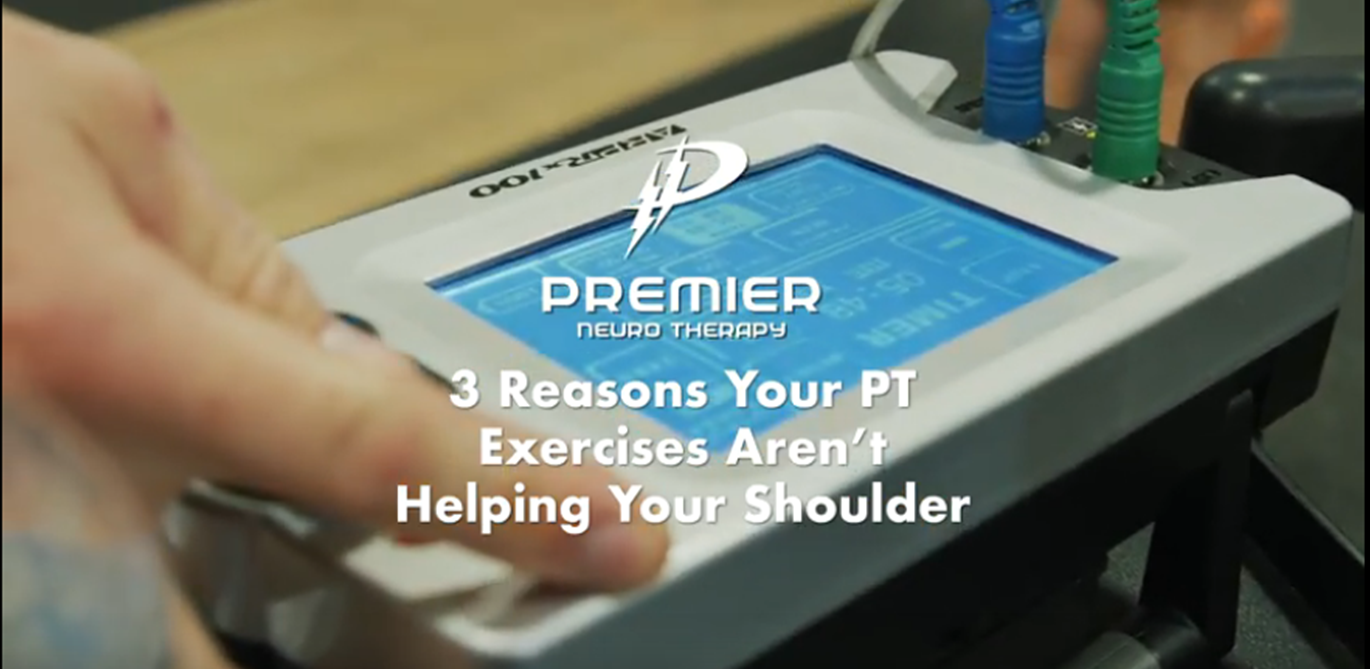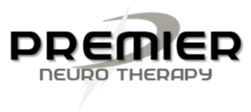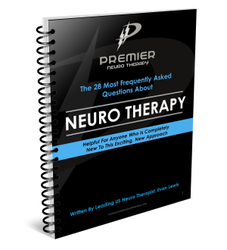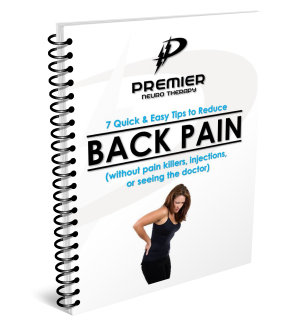|
The exercises your physical therapist recommended can be a great help to shoulder pain. However, if the nervous system isn’t functioning correctly, there’s a possibility they might not be providing the benefit you were hoping for.  There’s 3 different reasons your nervous system could be interfering with your physical therapy exercises: 1. The muscles in the shoulder and arm are stuck in a shortened, protective state. When an injury occurs or pain starts to develop, the nervous system immediately begins to place muscles around the shoulder in what we call a protective state. In the protected state, the muscles are limited to a much smaller range of motion, making them feel tight (and sometimes sore). You may notice as you go through your physical therapy exercises that your range of motion feels very limited, or that you’re unable to hold your shoulder in the position that’s recommended for the exercise. These are both indications that the muscles around the shoulder are stuck in a shortened, protective state, preventing your physical therapy exercises from giving you the most benefit. 2. You’ve learned compensation patterns that keep the correct muscles from working during the exercises. Think back to when you first injured your shoulder or started to experience pain. Did you immediately start using the affected arm a little differently? Maybe you started rotating your body a little more when reaching for objects, or pulling your neck down to your shoulder when reaching overhead. These adjustments to your normal movement patterns are what we call compensation patterns. Because your body believes a certain movement may be painful, it learns different ways to accomplish the same tasks. Let’s take one of the most classic physical therapy exercises: external rotation with a resistance band and see how compensations might affect the exercise (Video below). This exercise is often prescribed to help strengthen the rotator cuff – however, it’s rarely performed properly. The rotator cuff muscles are so weak that the body learns more efficient ways to perform the movement. If the wrist bends, elbow comes away from the body, or shoulder sits forward during the exercise (all compensation patterns), you will not get the intended benefit of the exercise. 3. Your nervous system is sympathetic dominant.
The nervous system constantly shifts on a spectrum between the sympathetic and parasympathetic state. The sympathetic state is more commonly known as our “fight or flight” response, which can be extremely beneficial in overcoming challenging situations. The parasympathetic state is commonly known as our “rest and digest” state, which is where our body does its most efficient repair and healing. When your nervous system fails to properly process stressors (whether they are related to work, relationships, exercise, nutrition, sleep, or a number of other factors), it can become what we call “sympathetic dominant.” When the nervous system is sympathetic dominant, it spends less time in the parasympathetic state, meaning it will not heal optimally (no matter how often you do your physical therapy exercises). So what does all this mean? If you want your physical therapy exercises to be effective, I highly recommend qualified supervision while performing the movements. Your physical therapist should be able to instruct you on how to perform the movements properly AND common ways they are done improperly. If you feel your forearm fatiguing during an exercise that’s supposed to be strengthening your shoulder, you’re probably doing it incorrectly, and need to communicate that with your therapist. If you believe you might have trouble processing stressors, ask your physical therapist for techniques on how to do so or if they can connect you with another professional with expertise in this area. At Premier, we use a number of techniques to overcome all 3 of these obstacle and optimize the recovery proceess.. Neuro Therapy helps to identify muscles that are in the protected state, fix compensation patterns, and re-train the nervous system to repair the shoulder efficiently. Click the link below to apply for a chance to experience Neuro Therapy for free: trial.premierneurotherapy.com A member of our team will review your application and determine if you qualify for a free Neuro Therapy trial. If additional information is required, we will reach out within 1 business day after receiving the application.
7 Comments
Joe mimlitz
5/19/2021 12:01:17 pm
A shoulder impingemenffor years might benefit from therapy no strength in shoulder
Reply
5/25/2022 10:29:35 am
My shoulder has been hurting a lot lately, and I'm not sure what to do about it. It makes sense that I would want to get physical therapy to see if that can help. It would be worth it to have less body pain.
Reply
1/22/2023 05:56:42 am
It made sense when you mentioned that strengthening your shoulder is part of the treatment. My friend wants to ease his shoulder pain. I should advise him to look for a doctor that specializes in shoulder pain treatment.
Reply
2/21/2023 05:25:10 am
When you think of sports medicine doctors, you probably think of doctors who serve professional athletes. But the reality is sports medicine doctors serve not only professional athletes and Olympic athletes, anyone - professional athletes, youth involved in sports, people of all ages who love sports, and factories...
Reply
6/11/2023 11:34:21 pm
Thank you for expressing that look back to when you first damaged your shoulder or started to suffer discomfort. My pal is an athlete. She has her first shoulder injury. I shall bring her to the shoulder discomfort sports therapy treatment.
Reply
G
12/27/2023 05:29:02 pm
Reply
Leave a Reply. |
About the AuthorEvan Lewis is a nationwide leader in Neuro Therapy and founded the Baltimore area's only specialist Neuro Therapy facility. Archives
February 2022
Categories
All
Local to the Towson, Lutherville-Timonium, Cockeysville, or
Hunt Valley area? Friends & Family receive a FREE Discovery Session at Premier!
|
|
About
Premier Neuro Therapy specializes in helping people overcome nagging pains and injuries, avoid surgery and injections, and transform the body to a state of peak performance.
|
Hours
Monday 8am-6pm
Tuesday 8am-6pm Wednesday 8am-6pm Thursday 8am-6pm Friday 8am-6pm Saturday Appointment only Sunday Closed |
Our Location
Our home base is just outside of Baltimore, MD, but we serve clients virtually throughout the United States!
15 miles north of downtown Baltimore, MD
|




 RSS Feed
RSS Feed